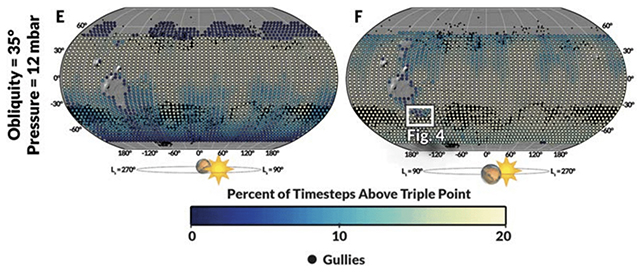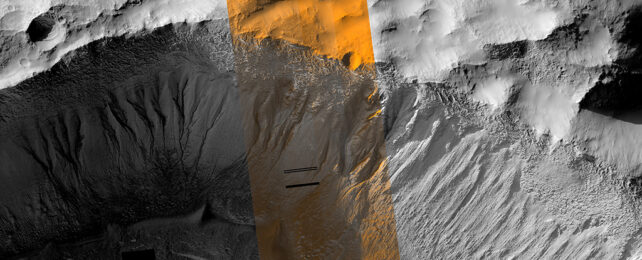Ravine-like channels on Mars are something of a puzzle. They look like the gullies in Antarctica caused by melting glaciers, but the elevated locations of many of the features aren't places we'd expect to find recently flowing water.
So how did these Mars gullies form? Sublimating carbon dioxide ice has been put forward as an alternative hypothesis, but a new study by a team of scientists in the US suggests that in the right conditions, liquid water really could do the job. What's more, it could've happened recently as far as geological timescales go, maybe just 630,000 years ago.
The key is the tilt of the planet's axis. When that tilt gets to 35 degrees, the new simulation of temperature and circulation shows, the density of the atmosphere would cause the surface to heat up above freezing point, briefly. It would be enough to melt some of the snow and ice that is still on Mars.
"We know from a lot of our research and other people's research that early on in Mars history, there was running water on the surface with valley networks and lakes," says Brown University planetary scientist Jim Head.
"But about 3 billion years ago, all of that liquid water was lost, and Mars became what we call a hyper-arid or polar desert."
The calculations run by the research team shed more light on how these gullies start, how much erosion they cause, and how far they can stretch. The team was able to fit its model to data on Mars' Terra Sirenum region, matching it up to periods when it's thought that gullies quickly expanded in the area.
A dual gully formation scenario, where channels created by melting ice are then further eroded by the evaporation of CO2 frost. These locations most likely still have reserves of ice trapped under the surface, and would've had significantly more in the past.
Flowing water erosion fits the features of the Martian landscape better than CO2-related erosion, which has no equivalent on Earth that we can study, and doesn't tend to cause the same effects on the rock it comes into contact with. This kind of activity has been observed on modern day Mars, through high-resolution satellite imagery.

"Our study shows that the global distribution of gullies is better explained by liquid water over the last million years," says planetary scientist Jay Dickson, from the California Institute of Technology.
"Water explains the elevation distribution of gullies in ways that CO2 cannot. This means that Mars has been able to create liquid water in enough volume to erode channels within the last million years, which is very recent on the scale of Mars geologic history."
The tilt of the axis of Mars is known to change over time, though it takes hundreds of thousands of years. This movement has previously been linked to ice ages on the red planet.
Running meltwater on Mars in the relatively recent past would have made it easier for organisms to develop, so the research offers an interesting new perspective on the potential of life on Mars too.
Eventually, the planet will go back to being at a 35 degree angle, allowing localized patches of liquid water to flow once more.
To bring it all the way back to the Dry Valleys of Antarctica, life remains in a kind of stasis when liquid water isn't available. It's not inconceivable that something similar might be happening on Mars as well.
"Could there be a bridge, if you will, between the early warm and wet Mars and the Mars that we see today in terms of liquid water?" says Head. "Everybody's always looking for environments that could be conducive to not just the formation of life but the preservation and continuation of it."
"Any microorganism that might have evolved in early Mars is going to be in places where they can be comfortable in ice and then also comfortable or prosperous in liquid water."
The research has been published in Science.
